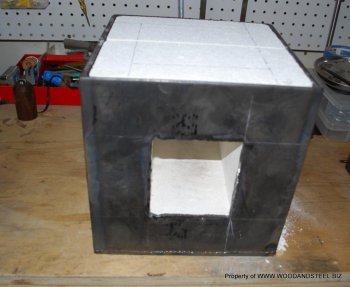For our applications, 1/4" fittings are the most common and appropriate.
Most setups will be plumbed in this order from the tank to the burner:
1. POL fitting.
This is the piece that threads into your propane tank. It will have a 7/8" hex to tighten onto the tank. It should have a 1/4" male fitting on the other end.
2. Regulator.
This gets threaded onto the 1/4" male end of the POL fitting. It should have at least two 1/4" FPT (female) ports, one on each end. Think of it as an "in" port and an "out" port.
Preferably, you want a regulator with a handwheel and a third 1/4" female port at the bottom to install a pressure gage.
Don't be afraid to spend money on a quality regulator. The Fisher brand is recommended; a cheapie will drive you nuts.
Regulators come in different ranges. 0-17 psi, 0-30 psi, 0-60 psi, etc. (The manufacturers no longer list them as "0" on the low end due to liablilities incurred when using the regulator as a shutoff device, so they say 3-35 psi, etc. But the regulator still operates down to 0.)
The 0-17 is best reserved for burners that are accompanied by a blower.
For your application the 0-30 should be fine, but the burner you have selected (T-Rex) can easily take advantage of higher pressures if the application calls for it. For example, 30 psi could give you over 65,000 BTU, while bumping the pressure up to 45 psi could give well over 75,000 BTU.
Whether you
need the extra pressure for more heat is naturally gonna depend on forge design and what exactly you're doing with the forge.
Some feel the smaller range (0-30) is more accurate; I have not been able to discern any noticeable difference.
But if you're like me, you'd rather have the ability and not need it, than to need it and not have it.:34:
3. Pressure gage.
This is optional, but even the "good" ones are relatively inexspensive. It should have a 1/4" male end that threads into the bottom port on your regulator.
The best results usually come from knowing your equipment, and knowing how your forge is really doing requires a pressure gage.
Match the gage to the regulator- if you have a 0-60 psi regulator, you want a 0-60 psi pressure gage.
4. LP hose in the length of your choice. I consider 5' the
minimum length, but we all have different setups in our shops.
The easiest hose to deal with will have a 1/4" male fitting on each end (so as to avoid adaptors).
One end of the hose will thread into the "out" port of the regulator. The other end will thread into the ball valve.
5. Ball valve (1/4")
This will have two female ends. One end threads onto the hose.
As evidenced by the fact that some "assembly kits" don't include a ball valve, lots of people don't use one, but it's the quickest shutoff device for the burner.
Note that ball valves can have different ratings. You want the one that's rated for gas.
6. 1/4"x1/8" pipe bushing
This is the fitting that connects the ball valve to the burner.
The 1/4" threads into the ball valve; the 1/8" connects to your burner.
Hope it helps you out.
Here is a diagram from Zoeller's website showing a layout similar to what I described. He uses an additional connector in his setup to connect the hose to the regulator due to the female end on the hose, whereas I prefer a male end on the hose going directly into the regulator.
http://zoellerforge.com/hookup.html
Both Wayne Suhrbier and Larry Zoeller sell various kits with the components to get you from tank to burner if you cannot source parts locally. By all means, if you're shopping locally, make sure they supply you with the stuff rated for gas applications. This also includes sealants like teflon tape (yellow) or pipe dope (Loctite 561, etc.).
http://www.hightemptools.com/propaneregulators.html
http://www.hightemptools.com/valves.html
http://zoellerforge.com/flare.html
Those are the plumbing basics to get your fire goin'.
Later down the road you might consider an idle (needle) valve arrangement. If you run your forge for long intervals, it will save you
considerably on fuel costs. This is essentially like a pilot light on your gas stove or house furnace. It allows you to turn off the forge burner (via the ball valve) yet still turn it back on without having to go through the ritual of relighting.
http://zoellerforge.com/idle.jpg
Good Luck,
Rob


